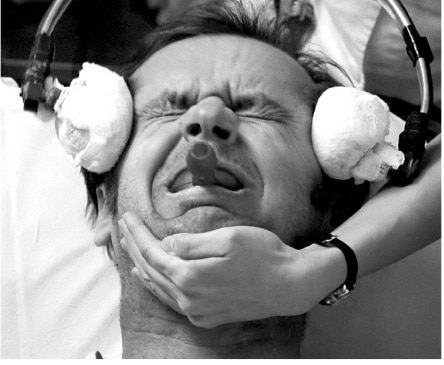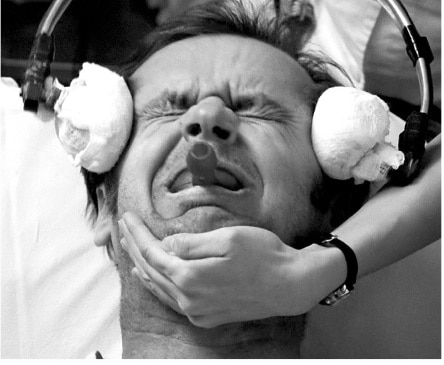The doctors’ advisory board of the Abdul Qadir Gilani Institute of Sufic Sciences deplore inhumane use of electroconvulsive therapy and psychotropic drugs, which have never cured mental illness
More than just a treatment modality used for every type of mental illness and behavioral aberration (real or contrived), the industry of psychiatry has created a deplorable, yet immensely profitable system of human oppression and suffering, with psychotropic drugs and Electroconvulsive Therapy (ECT). It is estimated that of those mental patients who have been administered this formidable and life-altering regimen, at least 10,000 people each year eventually succumb to the irreparable damage caused to their brains and bodies. These inhumane treatment methods that lead to death at worst, and brain damage at best, must be ceased as they have not, and will not ever cure anyone; instead offering victims extreme pain, a lifetime of misery and no retribution for those responsible for pure torture.
How was ECT developed?
In 1938, a Dr. Ugo Cerletti surmised, after observing pigs being given electrical shocks to the head that rendered them unconscious ( and ready for slaughter), that the same idea could be applied to his difficult mental patients. Upon initiating electric shock treatments – which induces seizures – to his unruly and aggressive patients’ brains, they became ‘meek and mild’. The new therapy was adopted quickly, without regard for the tragic outcome for the patient, who would never regain full brain function after the damage from the ECT treatment.
The first ECT’s were administered in the ‘unmodified’ form, without anesthesia or muscle relaxants, where the shock initiated a seizure that amplified to a full-scale convulsion, and is today still administered in this cruel manner in some countries. The procedure is extremely painful, with some patients suffering bone fractures; all suffer mental confusion and long-term memory loss. Researcher and psychiatrist Dr. Peter Breggin, in his paper entitled Destroying Lives writes, “Even when these injured people [after ECT] can continue to function on a superficial social basis, they, nonetheless, suffer devastation of their identities due to the obliteration of key aspects of their personal lives. The loss of the ability to retain and learn new material is not only humiliating and depressing but also disabling, and disrupts the routine activities of life.”
ECT causes irreparable brain damage.
And as early as 1952, Swedish researcher Hans Hartelius published findings from an animal study of ECT, where he found ‘shadow cells and neuronophagia’ and major changes in blood vessel walls in the brain, indicating irreversible damage to neurons after electroshock convulsions. In 2005, Russian researchers published a very detailed study in which they documented ‘significant brain damage’ after an ECT series. The neurologists concluded that there was ‘significant loss of neurons, and up to 10 percent of the brain cells killed in specific parts of the brain as a result of convulsions caused by the electroshocks’.
In 2008, a team of Portuguese researchers conducted animal studies and reported that their findings confirmed similar research in humans – that the convulsions caused by electroshock therapy resulted in lesions on the brain and cell death. According to Dr. Breggin, author of numerous reports, books, and journal reviews related to ECT, he categorically states that ECT routinely causes “widespread pinpoint hemor-rhages and scattered cell death.” Prior to this, even the US Surgeon General, in 1999, stated that ‘fears of gross structural brain pathology’ caused by ECT were not proven; however, in medical jargon ‘gross’ means major – so the Surgeon General did not deny that brain damage occurred. Dr. Breggin suggests that the traditional psychiatry establishment has a history of “systematically covering up damage done to millions of [ECT] patients throughout the world.”
Conclusive findings appeared in 2007, from separate research groups led by Dr. Harold Sakeim, Dr. Glenda MacQueen, and Dr. Peter Breggin, confirming that ECT leads to ‘widespread, persisting, and generalized cognitive dysfunction’. Dr. Breggin, as well as the majority of psychiatrists, still maintain that repetitive ECT treatments are necessary to see even minor improvements in the patient, and that the damage emerges and increases over an extended period of time. Global cognitive dysfunction impairs the victim’s identity and sense of self, as well as ruining the overall quality of life,and covers the entire range of mental faculties from memory to abstract thinking and judgment, writes Dr. Breggin of ECT patients whose substantive memory loss includes recall of major past life events. He cited the case of a nurse who lost so much of her professional knowledge after having ECT, that she was unable to continue her nursing career.
How is ECT administered?
The FDA recently confirmed the devices used to administer ECT will remain categorized as Class III of (dangerous) high risk. These devices, though extensively used, have never been tested for efficacy or safety, and are responsible for the brain damage, memory loss, and cognitive impairment caused to patients already suffering with mental disorders.
In the best case scenario, an ECT patient is given an anesthetic and a muscle relaxant, and occasionally, a drug to inhibit salivation. Electrodes from the ECT device are placed on both sides of the head (bilateral), which deliver an electrical shock stimulus that is above the patient’s seizure threshold – one and a half times, but often up to 12 times above – in order to cause a seizure. Determining the patient’s seizure threshold is a trial and error process. The type of ECT device used affects the nature and extent of brain damage caused by the electric shocks, with the sine-wave type causing the worst brain injury – the very devices primarily used in third world countries, Pakistan, Afghanistan, and Iraq.
An article published in 2007, in the Pakistan Journal of Neurological Science by Haider A. Naqvi and Murad M. Khan of the Department of Psychiatry, Aga Khan University in Karachi, Pakistan, describes the deplorable situation there in reference to the administration of ECT:
“Psychiatric practice in Pakistan is largely unregulated. The use of unmodified ECT, i.e., without general anesthesia or muscle relaxant, is carried out regularly in many hospitals (both government and private). This has repercussions on the outcome of the procedure. It is not uncommon to see patients ending up with serious complications such as fracture of the spine or one of the long bones in the limbs… many mental health facilities in Pakistan are known to overuse the procedure arbitrarily, without proper screening of patients. Improper prescription and screening of patients reflect uncertain standards of psychiatric practice. This has legal, ethical and socioeconomic implications that need to be addressed…, the administration of modified ECT [less harmful] is deemed as ‘preferable’ rather than mandatory. Unmodified ECT is unethical and can have serious life-threatening complications for patients. There is insufficient training of psychiatrists in the safe and effective use of ECT in training programs. Informed consent is often not obtained before the procedure, a reflection of the prevailing ethos of care in the country. There is good evidence to show there are more cognitive side-effects with ECT machines delivering sine-wave current, compared with brief-pulse current. Most machines in use in Pakistan are of the sine-wave variety.”
Psychotropic Drugs: Contributing partner in worldwide psychological repression and suffering.
Psychiatric drugs, the medications commonly used to treat mental illnesses, are used with ECT, as the electroconvulsive treatments alone are ineffective in the long-term. The hundreds of drugs in this category, with names from A to Z, have been designed to mask the negative symptoms of mental disorders and are complete with their own list of negative side-effects. Once again, the burden of third world countries, and those recovering from invasions (Iraq, Afghanistan, etc) due to lack of adequate monitoring, and corruption in government, is that harmful psychiatric drugs, which are banned in the US, UK, and Europe, find a lucrative market in those countries – the people suffering with mental illnesses becoming the victims. No drug has ever been proven or able to cure any mental illness, yet ,their proliferating sales volume – a direct result of physicians’ eagerness to prescribe them to their patients – promises to continue to provide pharmaceutical companies the billions of dollars they make yearly from sales of these drugs worldwide. They are prescribed for a particular purpose, however, with such a multitude of harmful side effects, that a different drug must be taken to counteract the adverse effects of the first. Diabetes, cardiovascular disease, high blood pressure, dementia, psychosis, increase in suicidal thoughts, tardive dyskinesia – a disorder that causes involuntary movements, especially of the lower face, including facial grimacing, jaw swinging, repetitive chewing with nothing in the mouth, tongue thrusting, and serious speech disturbances – are all common outcomes in patients being treated with the plethora of antidepressant and psychotropic drugs. The symptoms sometimes can be curtailed by stopping the causal medication, however, often, the involuntary movements become permanent and in some cases become worse – even once the drug therapy finishes. The inability of psychiatric drugs to cure patients with mental afflictions usually dictates that they must adhere to a lifetime of medications in order to function, and usually, they must remain in an institution that provides psychiatric care, as they are additionally disabled by the drugs. More disturbing and to further complicate this dilemma, the medical establishment has now expanded the spectrum of ‘medicinally treatable’ ailments by re-classifying emotional upheavals of life – such as PMS, post-partum depression, student stress management, and childhood temper tantrums, which occur normally, as ‘abnormal behaviors’.
The World demands an end to ECT
The conscience of the international community is perhaps influencing a slight trend against use of ECT. In Turkey, the practice of electroconvulsive therapy has been banned from its largest psychiatric hospital, and in the Netherlands and Italy, its use is severely restricted. In Japan, India, and Nigeria, it is legal (and the norm) to administer ECT without anesthesia or muscle relaxants. The World Health Organization (WHO) has called for a worldwide ban on this most inhumane type of treatment (unmodified ECT). However, western countries show no disdain – despite the fact that millions of lives have been ruined by ECT and psychotropic drugs.
ECT training is not requisite in US medical schools, nor is it required in psychiatric resident training; there are no national certification standards, and no continuing educational requirements for practitioners.
Dr. Peter Breggin makes this observation regarding the movement to halt this damaging and cruel procedure, which is continuing to disable and destroy the lives of an increasing population:
“The ECT lobby is …[very] organized, with its own journal and shock advocates positioned in high places in medicine and psychiatry. Stopping shock treatment will require public outrage, organized resistance from survivor groups and psychiatric reformers, lawsuits, and state legislation.”
It is our unwavering duty, before Almighty Allah, that we – the Advisory Board of the Abdul Qadir Gilani Institute of Sufic Sciences – repeat our urgent appeal to the psychiatric establishment, practitioners, and psychiatric facilities, to immediately ban the use of electroconvulsive therapy and its accompanying regimen of debilitating, crippling psychotropic drugs, for the Sake of The Almighty Creator, Who will surely charge those who continue to administer these dangerous and deadly treatments with major crimes against His highest and most beloved creation – mankind, the ‘family of Almighty God’.


ECT has long been known to cause serious harm to patients, including extremely severe and permanent memory loss, inability to learn and remember new events, depression, suicide, cardiovascular complications, prolonged and dangerous seizures and even death.






